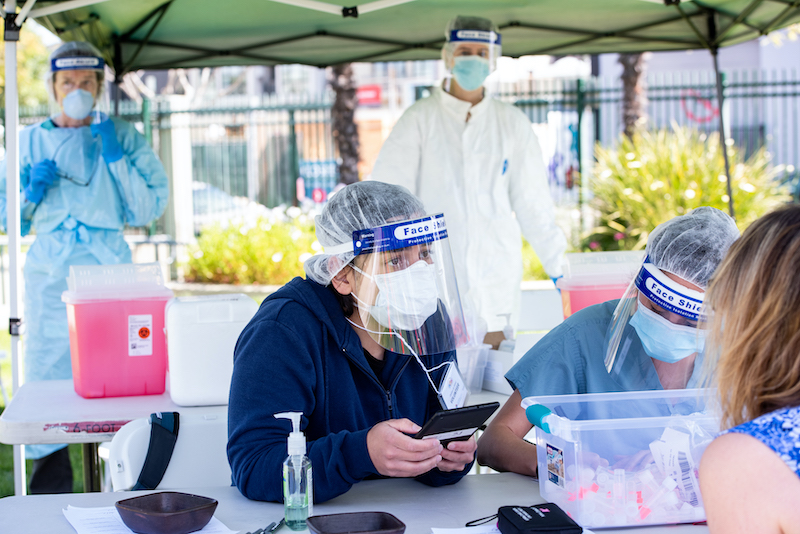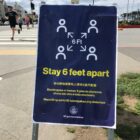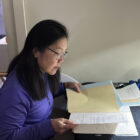This article is adapted from an episode of our podcast “Civic.” Click the audio player below to hear the full story.
As I recently waited to get the latest COVID-19 booster and flu shots at my local pharmacy, I found myself thinking about how much has happened in the four years since the start of the COVID-19 pandemic.
There was the lockdown in March 2020, the endless Zoom calls, then-President Donald Trump rambling about somehow injecting bleach or bringing sunlight inside the body to fight the virus, online conspiracy theories, political battles over masking mandates and many other jarring events.
I remembered my first COVID shot in a very quiet and solemn setting — then catching the virus months later but being down for only a couple of days as my vaccine-prepped immune system fought it off.
“Are you Mel Baker?” a voice asked.
I snapped back to the present, in the Walgreens aisle next to the cough drops. The pharmacy technician escorted me quickly into a little side room, I rolled up my sleeve and he gave me the shots. Then he was done and gone, without even signing my vaccination card — such a vital document during the pandemic and now it was not even an afterthought.
The card might be an apt symbol for how San Francisco, and possibly most of American society, is now treating COVID-19. It seems that we’ve pushed the pandemic into the collective “memory hole” — a place where those thoughts, feelings and traumas can be dropped, comfortably out of sight. We want to move on. That may help explain why only 69% of people in the United States finished their primary vaccine series, and just 17% got all of the boosters, according to 2023 figures from the Centers for Disease Control and Prevention.
I think it’s important to look back and reflect. We have to reckon with the loss of life and the loss of trust in public institutions in order to prepare for the next pandemic.
“Civic” and the San Francisco Public Press are working on stories about people living with long COVID.
Do you have a story to tell? Please contact us at [email protected].
It should not be so easy to forget that nearly 1.2 million people in the nation have died from COVID-19. Almost 7 million required hospitalization. Millions more live with the symptoms of long COVID.
But this also wouldn’t be the first time that society has responded to great loss by putting something down the memory hole.
Survivors of the 1918 Great Influenza were quick to put it behind them, some historians say, and it is all but forgotten today. Only a tiny memorial in the Hope Cemetery, in Barre, Vt., marks the loss of at least 675,000 people living in the United States, when this country had about one-third of today’s population. Then, as well, there were fights over mask mandates and social distancing, though no vaccines to slow the flu’s spread.
Many people also wanted to forget about the HIV/AIDS pandemic after new drugs made it possible for them to live with the virus. But some survivors want to remember, in order to heal from the trauma.
In 2014, more than three decades after HIV and AIDS ripped through the country, Greg Cason started the program “Honoring Our Experience.” It brought together people who had lived through the pandemic so they could process the experience.
“There was something powerful about creating a space for that community of people,” Cason told me. They realized the AIDS pandemic had given them “a unique and profound experience that only they would understand.”
Kristin Urquiza co-founded the group “Marked by COVID,” which helps people memorialize those who died so that society does not forget. The group is trying to have a permanent monument to the pandemic placed in Washington, D.C.
“In this era of global warming and everything else, we’re going to get another pandemic.”
Dr. Monica Gandhi
Urquiza was inspired by activists who used the AIDS Memorial Quilt to personalize the dead and force a better government response.
For her father, the desire to move on had deadly consequences.
“He got sick early on in the pandemic, in the summer of 2020, right after the state of Arizona re-opened,” she said, referring to his COVID-19 infection. “The governor at the time was basically spreading misinformation that it was safe to resume normal activities.”
“I think that the need to commemorate and memorialize allows us to move past the divisiveness and the politicization of COVID,” Urquiza said. She added that doing so is necessary to prepare for whatever comes next.
Dr. Monica Gandhi agrees. She is the author of the book “Endemic: A Post Pandemic Playbook.” The term “endemic” applies when a disease becomes ever-present in a population.
Today, the greatest threat to public health is the lack of trust in government institutions, she said. That’s in part a consequence of the shifting, confusing guidance that U.S. health agencies gave in response to COVID-19.
“We have the vaccine, take it, but you’re gonna need booster after booster,” she said, recalling the government’s guidance. “And oh, by the way, we’re not gonna let you go back to a normal life.”
The U.S. government’s messaging was also in stark contrast with how it had handled the AIDS pandemic decades prior, when new drugs made the disease manageable for most people in the mid-1990s.
“We got these biomedical advances like protease inhibitors and life turned around” for the people who took them, Gandhi said. At the time, people celebrated a return to normalcy.
Her book contains a list of recommendations for the next major outbreak:
- The government must spring into action to develop and distribute vaccines, especially to low- and middle-income nations.
- Pharmaceutical companies should develop antivirals and other therapies to treat the infected, similar to the prescription drug Paxlovid and the infusions of monoclonal antibodies — laboratory-produced proteins intended to stimulate the body’s immune system — used to battle COVID-19.
- Celebrate medical advances by easing restrictions, when possible.
- Avoid what she calls “medical rituals,” like cleaning groceries with bleach or taking temperatures at airports.
- Keep public parks and playgrounds open to avoid isolation and get people out of buildings where respiratory viruses are more likely to spread.
- Re-open schools as soon as possible, especially after teachers have been vaccinated, to avoid learning loss and social isolation among children.
“In this era of global warming and everything else, we’re going to get another pandemic,” Gandhi said.
Read a Q and A with Dr. Gandhi about how she and her colleagues reacted to the greatest pandemic in a century in our Reporter’s Notebook piece, “The Epidemic She Didn’t Expect to See.”










